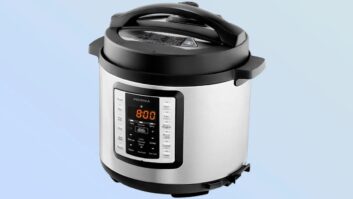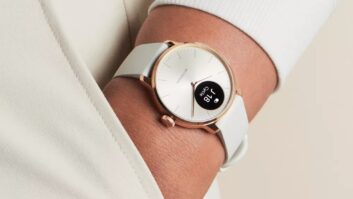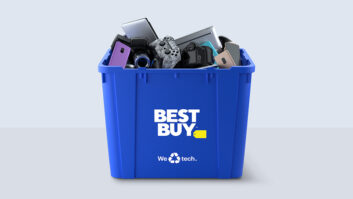As part of their presentation to shareholders, Best Buy officers led by president/COO Allen Lenzmeier broke out the company’s business units and outlined their short-term goals for each during last month’s annual meeting here.
The overarching strategy is to service what the company perceives as two distinct “eco-systems” — entertainment and in-home — with a multi-brand approach. At the same time, it plans to bring Best Buy’s best practices — including innovative store design and knowledge management — to each of its new divisions while sharing the best ideas from Musicland, Magnolia and Future Shop with all.
The company is also looking to leverage its vendor relationships to develop new, complimentary businesses that will further entrench it with consumers.
Here’s a look at the game plan:
Best Buy Stores
Best Buy caters to techno-savvy 15- to 44-year-olds with annual household incomes of $50,000 or more. This group encompasses technophiles, active singles, and young fun-seekers that like the stores’ low-pressure atmosphere and grab-and-go merchandising displays.
The company has been adding about 60 stores a year and will have some 540 units by 2003. As large markets reach saturation with the standard 45,000 square foot stores, it will increasingly tap into secondary markets with populations of about 200,000 with a new generation of 30,000 square foot stores. Some 90 of those configurations will be built during the next three years, while the balance will be in the larger, newly developed Concept 5 format, which was designed to better showcase digital products.
At the same time, the company will begin drilling down to tertiary markets with populations of 100,000 via a 20,000-square-foot prototype store. Tests of two such units will begin this October in Texas and the state of Washington.
Lenzmeier said the company will eventually top out at 800 Best Buy stores in total.
Best Buy places a tremendous emphasis on customer satisfaction and loyalty as a means to increase the amount of money consumers spend in its stores. Customer loyalty is measured monthly, with the goal of attaining a 50-percent “very favorable” rating by shoppers.
On the product front, several initiatives are in the works. Targeted areas include:
- Appliances. Best Buy has spent the past two years “re-engineering” its major appliance business in an effort to improve execution. The company currently has a 5 percent market share in white goods, which is the smallest of any category it carries. Majaps also has the lowest close rates of any Best Buy department. The company believes that there is a “significant opportunity” to double its majap market share through improved assortment and better systems to manage that business, Lenzmeier said.
- Computers. Taking a page from the Dell playbook, Best Buy is stepping up its after-sale service by bringing fulltime repairmen into its stores. The move follows a six-month pilot project that resulted in improved turn times and a reduction in complaints. “Service after sale is critical,” Lenzmeier said. “Now, customers will be able to bring their broken PC to the store.”
He said the new service will help increase customer loyalty, and added that the company is also looking at providing installation services for in-home networks. - Video. In anticipation of significant growth in high definition, plasma and LCD TVs during the next five years, Best Buy will begin testing a new design for its video departments this fall that better demonstrates the features of high end products. A national rollout will follow.
In addition, the company may eventually offer in-home installation service for plasma TVs that would either be outsourced or developed in-house.
As Mike Keskey, president of Best Buy Stores noted, the idea is to offer consumers “complete solutions” that include accessories, services and extended warranties, rather than just products alone. One graphic demonstration of that is in Best Buy’s home theater area, dubbed Project Living Room, where more services are being incorporated into the sales floor. - Bestbuy.com. The company has rolled its e-commerce unit into the Best Buy Stores operation under Keskey. As Lenzmeier explained, a significant opportunity exists to sell more by providing customers with access to the Web site in stores.
Musicland
The company plans to significantly expand the group’s stores into small and rural markets, where they can benefit from lower real estate and labor costs. In light of the soft music software market, the group will expand its assortment of video games, and some 200 Sam Goody stores will be re-merchandised with DVD software. The company will also “intensify” its re-merchandising of Sam Goody with personal electronics, Lenzmeier said.
Longer term, the group is “looking at broader entertainment areas like satellite dishes, satellite radio and concert ticket sales,” said Musicland president Kevin Freeland. He added that despite a sharp decline in CD volume, the entertainment software category is still growing via DVDs and video games.
“We’re allocating floor space toward growing businesses and managing the resources behind declining businesses,” Freeland said. “We have the numbers, the total area is growing, but we just wish it was more robust on the music side.”
Magnolia
The specialty A/V chain boasts an affluent customer base of consumers ages 35 to 54 with annual household incomes of $75,000 and higher. There is little overlap between Magnolia’s SKUs and those of Best Buy.
The company is opening six new stores in San Francisco, which will bring the store count up to 19. It ultimately envisions 150 Magnolia stores nationwide, and believes it can build the chain into a $3 billion business by expanding its product and service offerings.
International
At this point the company’s international endeavors are limited to Canada, which is serving as a training ground for eventual offshore expansion.
As the first order of business, Best Buy is beefing up its Future Shop chain by bringing over such best practices as inventory management, advertising effectiveness and complete solutions selling. Through these measures the company expects that it can increase Future Shop’s profitability from 2 percent to 4 percent, which would match that of Best Buy stores.
The company also believes the Canadian market is ripe for expansion, and plans to build 30 new Future Shop stores, remodel existing ones, and open upwards of 65 Best Buy stores north of the boarder. The Best Buy brand will first appear in Toronto, where the first of eight units will open this fall.
According to Lenzmeier, Future Shop presently commands a 15 percent share of the Canadian CE market. With the addition of new stores and Best Buy, the company believes it can boost its total market share to 35 percent.
As chairman Dick Schulze explained, “Historically, there are two key leaders that outperform the field in any industry. Rather than have competing brands like Wal-Mart and Target, or Circuit City and Best Buy, we’ll have a co-branded situation. We’ll control both brands.”
Tom Healy, president of Best Buy International, added that the only way to reach a 30 percent to 35 percent market share in Canada is with two brands, and he assured shareholders that the two franchises would be differentiated in the marketplace.
The company wouldn’t pinpoint its first overseas venture, although Europe is the likely target. “We’re looking at opportunities everywhere,” was all Healy would say on the subject, “and Canada is our current direction.”












